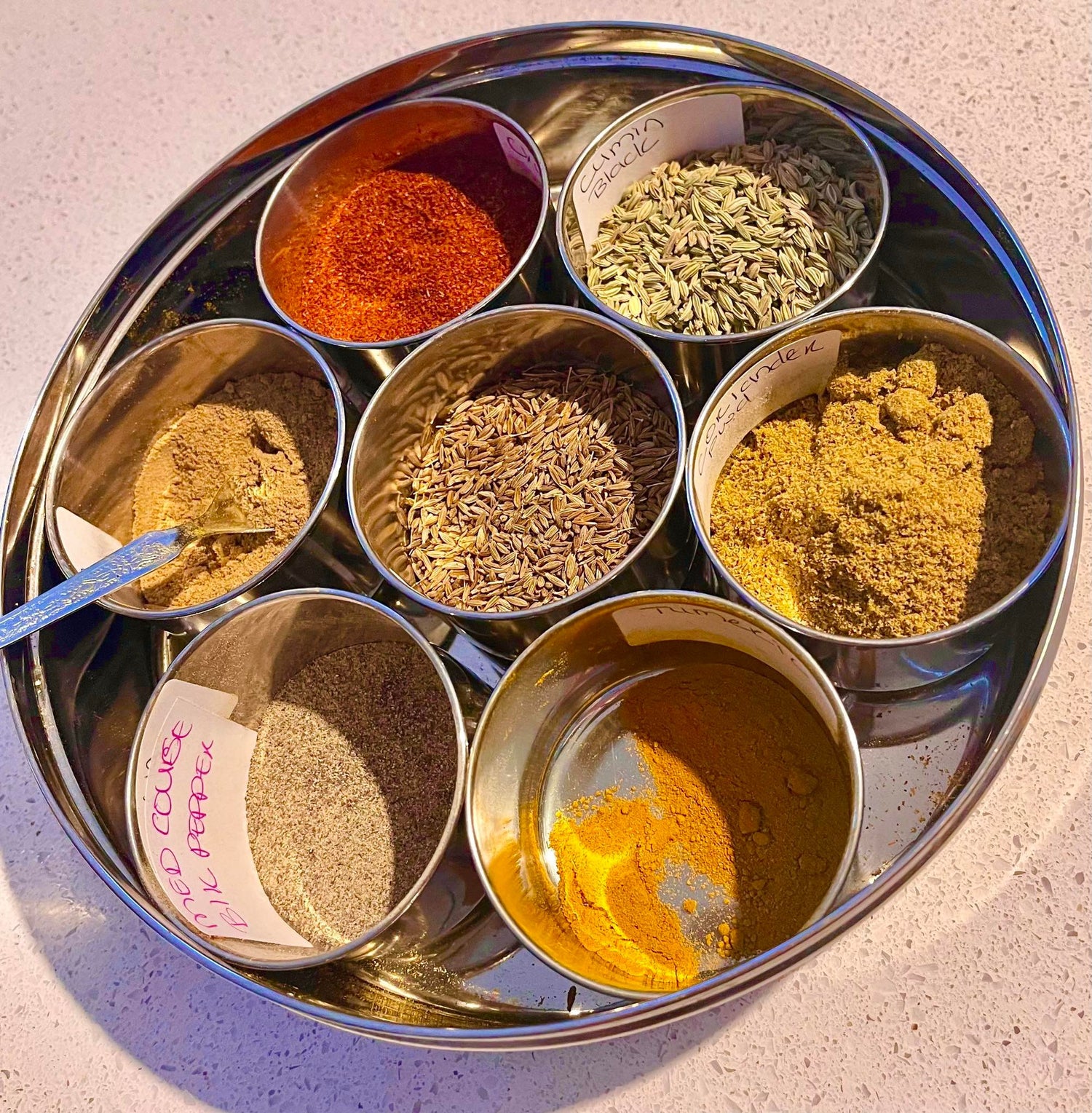
The amazing benefits of Kitchari Fasting
Kitchari Fasting a cleansing ritual
We begin every new season with high hopes and goals. Many of us make resolutions to do things better, excercise more, eat healthier and so forth. I would like to share an Ayurvedic Kitchari recipe that will not only get you off to a great start — but also help you on your way to a healthy future.
I try to do a Kitchari fast four times a year between the seasons. The process helps to offload residue from the previous season and prepare me for the next one. What I love the most is Kitchari fasting is that it is an easy way to detox, lose weight and boost energy!
25 Years of Kitchari Fasting
I have been eating and fasting with Kitchari for over 25 years. It was a staple in our family and is still one of our favourite meals when we all get together.
For those unfamiliar with Kitchari, it is a traditional Ayurvedic dish used for cleansing. The mixture consists of yellow mungbean, basmati rice and Indian spices.
Kitchari fasting is one of the most powerful ways to cleanse your body and a simple and effective way to detox your entire system.
Ayurvedic Principles
Ancient Ayurvedic principles guide a Kitchari fast.
- During the fast rice and mung beans are eaten without any other food for some time.
- One of the most important things to remember when fasting with Kitchari is to drink plenty of water and herbal teas throughout the fast.
What I love most about Kitchari fasting is that it's a great way to cleanse the body while still being able to eat regular meals.
The purpose of fasting is to eliminate ama (toxins) from the body, which can be caused by diet, pollution, or stress, as well as gently bring the body and mind into balance.
Another reason I love eating and fasting on Kitchari is because it is a complete protein.
Why this combination is so effective.
For 10,000 years, the combination of rice and beans has been a staple food worldwide, with good reason.
Here's why :
- 20 amino acids join together to create the proteins the body uses.
- The body can synthesize ten of the amino acids that are called "nonessential."
- The other ten are called essential amino acids because we must get these from our diets to survive and maintain healthy bodies.
- The body cannot synthesize them on its own.
- Rice and beans, combined in the right proportion, complement one another.
- While rice has all of the the amino acids we need, except lysine and methionine (which are abundant in beans), lacks tryptophan, among other essential amino acids found plentifully in legumes.
Combining these two foods in Kitchari gives us the nutrients we need all in one place! This is why fasting on Kitchari is ideal for those concerned with malnutrition and loss of energy, which can be experienced during water and juice fasting.
How Kitchari Nourishes and Cleanses to keep Energy Levels High
The complete protein found in Kitchari provides nourishment during a cleanse and helps stabilize blood sugar levels. Otherwise, ironically, the body may react to a cleanse as an emergency situation that requires fat storage! Yet another reason I love Kitchari fasting, as it simultaneously nourishes and cleanses the
body, so that during the fasting period, energy levels are high and there are no ill effects like headaches, lethargy, etc.
I also love Kitchari fasting for the benefit of weight loss!
A cleanse should include protein to keep blood sugar levels stable so that you feel satisfied and do not overeat. I love Kitchari fasting because it is an easy way to detox, lose weight and boost energy.
Many people have difficulty cleansing due to their unstable blood sugars, which can make cleansing difficult and worsen by detox. During fasting, for example, when you are asked only to drink water or juice, blood sugar levels will drop dramatically and cause energy crashes in some individuals.
For some people, fasting like this can be too hard on the body and cause blood sugar levels to plummet and become hungry, irritable and then get a headache or feel weak from low blood sugar.
If the body is stressed and under strain, it will not be able to metabolize fat or eliminate toxins. Kitchari Fasting is different because it allows more carbs during your fast to stay energized while detoxing!
Kitchari for Spiritual Benefits
Some of the other reasons I love doing Kitchari fasting is the spiritual benefits I have received, such as:
• Inner peace
• Improved mediation concentration
• Better flow and ease in my yoga practice
As well as:
• less negative mind activity
• More control over emotional eating
• Improved taste buds
• Over all better concentration
• Improvements with skin tone, healthy hair and clearer vision
Weekly Kitchari
In addition to seasonal Kitchari fasting I also like to have it one day a week, where I eat only Kitchari. I have found that when eating it once a week I am able to maintain all the benefits from the seasonal fast.
Kitchari is a great medicine for the body, mind and soul. It's a tonic that helps you to feel happy and strong when your health isn't at its best.
It's also a delicious companion food during festivals or fasts; it gives warmth in cold weather and nourishment when you are sick or low on energy. Pretty soon you will crave it, just like me!
I hope you will give Kitchari a try! I am certain that you will love the ease and simplicity of this Ayurvedic detox fast and weekly meal.
Here's my tried and true Kitchari recipe!
You should be able to have enough for three to four meals. I prefer using whole bean mung, as I have found it to be less constipating than the split yellow dhal. Traditionally it is made with yellow slip mung bean.
Also, you can play with the mixture of spices. Many prefer this recipe when the spices are doubled, or even tripled. However, for fasting, I like to keep spicing at a minimum, as the idea for the fast is to balance our mind and bodies. With added spicing and flavour, the tendency to overeat is accelerated.
In my recipe I use refined coconut oil. Ghee is another option. However for cleansing, I recommend that the kitchari be made with less or no ghee. and or very little coconut oil as well. Because ghee is fat, it will slow the shift into fat metabolism. The less ghee you use, the more effective your cleanse will be.
You can start by browning spices in 1-2 tbsp of ghee or refined coconut oil.
Ingredients:
SOAK FOR 8HRS
1 cup green whole mung beans*
1 cup white basmati rice
AFTER SOAKING RINSE WELL AND DRAIN
__________________________________
1 TBS fresh ginger root - CHOP
1 TBS fresh turmeric - PEEL AND GRATE
1/2 tsp black pepper mustard
1/2 tsp cumin seed
1 tsp turmeric powder
2 tsp coriander powder
1 tsp fennel
3 TBS coconut oil (refined)
ROAST ABOVE AND THEN ADD WATER
8-12 cup water
2-3 Bay leaves
3 tsp salt (CELTIC salt is best)
COOK UNTIL BEANS AND RICE ARE SOFT AND PORRIDGE-LIKE TEXTURE
Method:
Wash mung beans and rice together until water runs clear.
Soak for 8 to 10 hours.
In a pre-heated large pot, dry roast the ginger and all the spices (except the bay leaves) on medium heat for a few minutes. This dry-roasting will enhance the flavor.
Add mung beans and rice and stir, coating the rice and beans with the spices.
Add water and bay leaves and bring to a boil.
Boil for 10 minutes.
Turn heat to low, cover pot and continue to cook until mungbeans and rice become soft (about 30-40
minutes).
For weak digestion, gas or bloating: Before starting to prepare the kitchari, first par-boil the split mung dahl (cover with water and bring to boil), drain, and rinse. Repeat 2-3 times. OR, soak beans overnight
and then drain.
Cook as directed.
Happy fasting!


Leave a comment